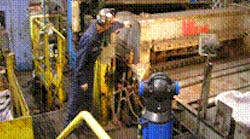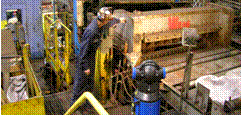In web-based processes, speed is (almost) everything, so much so that competitive forces continue to drive line speeds to new records yearly. A generation ago, a go-fast paper mill whirred along at 2,200 fpm. Today, plant managers boast about the same numbers, only now they are talking in meters per minute: 3.28 times faster! That makes more products available for market, but more importantly, specific labor costs – the largest expense of many web processes – plummet.
Positive control
The one unyielding standard to advances in web speed is quality. It does no good to make product fast if it is off spec. Manufacturing engineers have learned and relearned one simple truth: The faster the speed, the better web-handling surfaces must fit together.
In an ideal sense, a web is a 2-D process; a plane that tracks around rolls that lie on parallel axes. But metrology specialists know that in real life, they have 3-D and even 4-D properties. When a web encounters rolls that are out of the design plane, it can “bag” – even a fraction of a degree of misalignment can cause a buckle or wrinkle. Also, the weight of a web can cause a roll to sag.
Paper is particularly unforgiving of misalignment. Running at 1,800 to 2,200 meters per minute, the dynamics in the sheet include heat transfer and moisture removal – while shrinking. Positive tension must be maintained across the sheet as it passes over rolls and between sections to prevent breaks.
Until recently, alignment faced a technological barrier. Optical systems could maintain roll-to-roll position and parallelism to an absolute accuracy of 0.005 in. over a distance of 50 ft.; but more realistically, global accuracy was closer to 0.060 in. In addition, these instruments require that cardinal points (3 o’clock and 9 o’clock) on a roll be visible, and the level of the roll can only be checked by a second instrument.
Also, repeatability is a problem: Two technicians can measure the same hardware and get different values. Thus, the checking and rechecking is time-consuming. As line speeds moved past 1,000 meters/minute, the lack of accuracy and repeatability were not good enough to prevent web fluctuations that led to breaks. In this respect, alignment, not horsepower, became a kind of empirical speed barrier. A better way was needed to set up the new super-fast webs.
On track
Doug Ursel figured this out on the job. He is the owner of Pine Falls Technical Services Ltd., a metrology-consulting firm in Manitoba, Canada that provides alignment services to the paper and printing industries in Central Canada and the upper U.S. Midwest. Over the years, Ursel has watched machine speeds rise and alignment tolerances shrink, to today’s roll-to-roll standard of 0.002 in./meter of machine length.
“A twist between rolls can lead to a loss of tension and positive control in the sheet. At 1,800 meters/minute, a sag becomes a wrinkle waiting to happen.”
To evaluate alignment, Ursel uses a laser system that seems to have been designed with paper mills in mind because it can measure extreme range with extreme precision. The FARO Laser Tracker from FARO Technologies, Inc. can locate a spot 230 ft. away. In the ADM mode, distance measuring accuracy is 10 µm + 0.4 µm/m; angular accuracy is 18µm + 3 µm/m. From its tripod setup, it projects a beam that is reflected from a movable target/probe back to the sending unit where the software in the system pinpoints the target. As a technician walks the target along a machine frame or roll surface, the Tracker follows its path, recording position points as it goes, Figure 1.
Figure 1. Tracker follows a movable target that is placed at multiple locations on machine surfaces so that alignment can be analyzed. Photo: Falk P.L.I.
Ursel finds the FARO Tracker ideal for aligning paper machines and printing presses that stretch several hundred meters from end to end. He used to employ the optical systems that were the standard way of doing alignments, but being limited to line-of-sight measuring, they were slow. Also, they could not deliver laser precision.
By contrast, the laser measures rapidly, a feature that is becoming increasingly important. A technician can work around an obstruction, measuring long drive shafts, aligning pillow blocks, or gearbox mounts that are not visible to an optical system. Rolls with tapers do not require offsets in the instrument, and roll level is recorded at the same time the other dimensions are recorded. Eventually, a 3-D image of the measured surface is generated in the instrument’s computer.
“Plant shutdowns used to last for a couple of weeks. Now we are lucky to get a few days,” he noted, citing a project to align a calendar stack. “We had a day to do this and finished in less than 10 hours; with an optical system, this would have taken twice as long.”
More speed from existing equipment
Most of the news about advances in machine speed comes from new installations, but aligning existing equipment to tighter standards often increases its speed. Ursel provides a couple of cases in point.
Printing presses present unique alignment problems. Because the images on brochures, magazines or newspapers have to be sharp, the four press plates have to be in registration. Ursel aligned a four-color web press to the 0.002 in./m standard and watched as machine speed was increased from 500 to 700 fpm with good registration.
In another case, his Pine Falls group aligned a plastic printer/slitter that produces labels for 2-liter drink bottles. In a single operation, a 48-in. web is printed, slit to the proper label height. Running at its original alignment, machine speed was limited to 300 fpm. After realignment to an accuracy of 0.005 in., line speed was doubled.
Better metal
Because metal is more elastic than paper, it would appear that metal rolling is more forgiving of misalignment than papermaking. This is not the case. In metal rolling, the limitation in productivity is as much one of quality as it is speed, although high line speed continues to be necessary for a plant to be competitive.
Rolls that vary from the “passline” produce slabs and sheets with surface cracks and centerline segregation that make them unsuitable for subsequent processing.
Thick slabs can destroy rolling equipment from their mass alone. Those that are 4-8 ft wide and 6-10 in. thick overload bearings and bend rolls, accelerating wear. Thin foils do not exert the same destructive affects on processing lines, but behave more like paper or film, with the same need for positive tension to prevent wrinkles and sags.
Small deviations on a casting line
Mike Falk knows the importance of keeping rolling mill rolls on the passline. As owner of Falk P.L.I. in Portage, Ind., he and his engineers are called into rolling plants all over the U.S. in order to improve alignment.
A recent project involved the large casting mill at Claymont Steel in Delaware where 10- x 80-in. slabs are continuously cast and rolled. Maintenance engineers at the mill had been wrestling with alignment since its installation. Design tolerance for the outer radius rollers is ±0.020 in. from the passline, but optical and mechanical alignment could not deliver the level of quality that was expected. In search of improvement, Claymont engineers resorted to strand condition monitors (SCMs) and elaborate alignment jigs where roll subsets could be aligned prior to installation. Still, slab quality remained below expectations, while roll and bearing loads — and the resulting wear on them — remained high.
As a demonstration of the new alignment concept, Falk engineers performed a partial alignment with a FARO Tracker. Because the laser feeds data into a project file its on-board computer, Falk engineers were able to digitally “reconstruct” part of the line and establish the true 3-D relationship between the rolls. Using the data from the laser, they developed a proprietary software program to determine the correct shim height for each bearing pad. With this, they were able to show where to add or subtract shims to realign the rolls.
Improvement was immediate: Slab quality had never been better. Based on these results, a full line alignment was ordered. Surveying the entire casting line with the Tracker, Falk engineers found several operating anomalies, seemingly small, but which proved to be huge in terms of their affects on product quality. Specifications called for the centerline of each roll and mating roll to meet at the caster outer radius apex. However, roll pairs proved to be off by as much as 1.0°. In addition, bearing pads were not machined to “as built” drawings. Finally, bottom frame bearing seats for stationary segments were off the passline radius by 0.9°.
When all corrections were made, the mill experienced a quantum leap in quality. Rejects dropped 90% and the cost of replacement rolls and bearings dropped $250,000 per year — for each. In a footnote to the project, the software program developed by Falk engineers won a Reliability Achievement Award for improvement in streamlining maintenance practices, from the AIST.
Chuck Pfeffer is senior technical product manager, Laser Division, for FARO Technologies.

